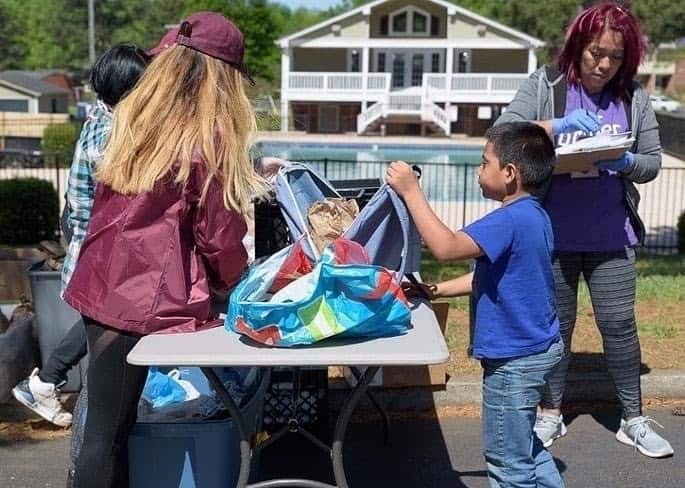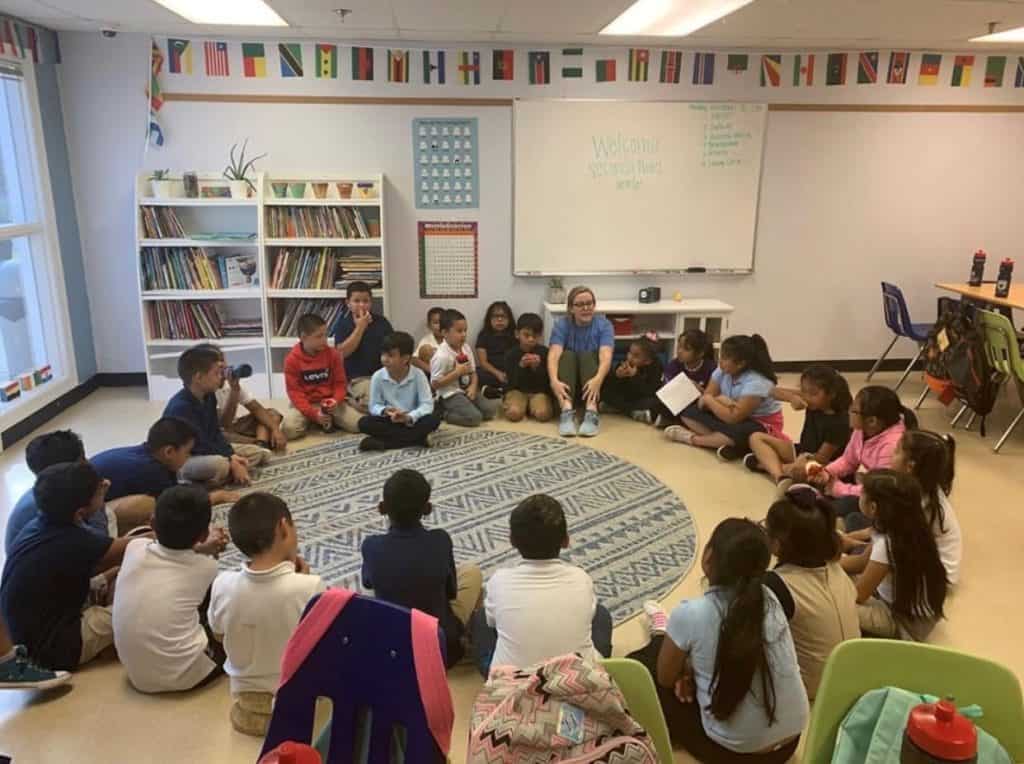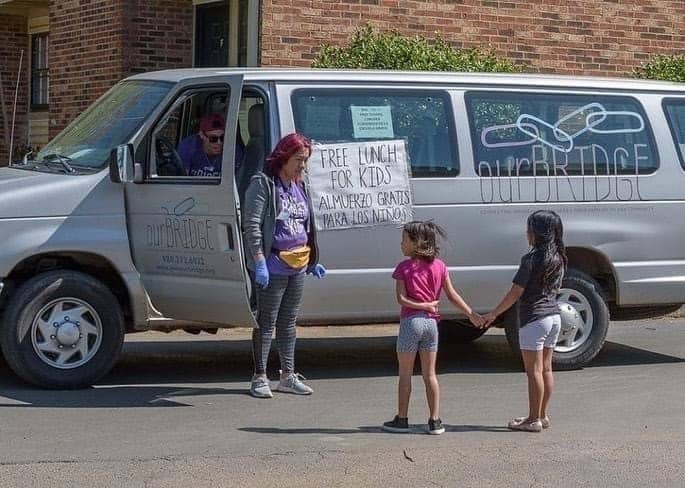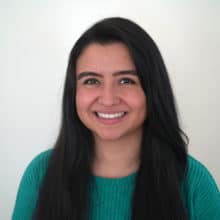This article is part of a series and ongoing reporting on Latinx communities in North Carolina. Click here to read more.
Food coloring (only five drops) and Alka Seltzer — combined with water and oil, those are the only materials needed to make a lava lamp. When staff at the Charlotte-based nonprofit ourBRIDGE for KIDS saw little student enthusiasm for virtual homework support in May, they portioned out those ingredients, hand-delivered them to the homes of their kids, and filmed three instructional videos: Spanish, Nepali, and Arabic translations of the English directions.
“This way, the parents have a way to be engaged,” says Salma Villarreal, community engagement coordinator at ourBRIDGE. “We’re making it accessible in their language where they can also do the activity with the kid.”
Whether the task is getting kids to complete a STEAM experiment or delivering 100,000 meals to neighborhood families, ourBRIDGE for KIDS is ready to provide for Charlotte’s refugee and immigrant communities, removing barriers to access wherever they appear.
In 2014, Executive Director Sil Ganzó founded the organization after a for-profit tutoring company discontinued an after-school program for Charlotte-Mecklenburg Schools’ Title 1 students. Ganzó, who served as that program’s director, took ownership of the project and transitioned many of the same staff, volunteers, and families to a new home — ourBRIDGE for KIDS.
“I saw that there was a huge gap — not just a gap, an inexistence of services for children who were transitioning to the United States that were not faith-based,” Gonzó said. “We wanted to give parents that choice to be in a place that was designed for kids who were learning to speak English, where they could celebrate their traditions, cultures, and celebrations, and actually have the opportunity to teach each other about it.”

Before the COVID-19 pandemic, ourBRIDGE provided two core services: after-school and summer programming for K-7 students living in east Charlotte, a diverse collection of neighborhoods home to large immigrant and refugee populations. Of the roughly 180 students served by the organization last year, nearly half were from Central America and the rest represented a wide range of African and Asian countries, namely Nepal, Burma, Ethiopia, and Eritrea.
During the traditional academic year, students spend two to three hours directly after school at the ourBRIDGE center, located in the heart of east Charlotte on the campus of the Aldersgate Retirement Community. Programming is exhaustive — upon arrival, students eat dinner, then spend time on socio-emotional development via play or informal chats with staff and volunteers.
“For some of the students who are struggling, this is the time that we’ll do check-ins with them,” Villarreal said. “Just how their day was, what are some goals for the day, talk about emotional regulation skills. We believe really strongly in free play, so they go outside — self-directed play — giving them tons of opportunities to de-stress.”
Once all students arrive at the center, they are split into grade-level bands and participate in “welcome meetings” — whole-class discussions during which students share their feelings on the day. The rest of the afternoon is spent on academic support and enrichment. School-assigned homework is completed first, then students transition to a uniquely designed ourBRIDGE curriculum prioritizing English language acquisition.

At the beginning of the academic year, literacy facilitator Linda Lang creates intensive personalized reading plans for each ourBRIDGE student. Using two tests — the Burt Reading Test Decoding Assessment and Salford Sentence Reading Test — Lang determines a student’s reading level and compares it with their age. With the results, she is able to provide staff and volunteers with intervention strategies, supports, and texts to facilitate reading growth. Daily, students receive 15 minutes of one-on-one reading support; some received more than 20 hours of individual instruction over the course of the last year.
The curriculum also emphasizes STEAM, culturally responsive teaching, and experiential learning, much of which occurs on field trips during the four-week ourBRIDGE summer camp. Instruction is organized into community-oriented thematic units such as “CHANGE SI SE PUEDE! — Who can create change? How do we create change?” In this most recent unit, students modeled the work of local and international leaders as they created projects addressing global issues.
To conclude daily programming, students are fed once again and leave the center on one of three ourBRIDGE vans — with an daily average of 150 students, nine trips are needed to ensure each child gets home safely.
The holistic approach to after-school programming is made possible largely due to the size of the ourBRIDGE team, which comprises four full-time staff, 24 part-time employees, and approximately 200 annual volunteers. Notably, 75% of staff identify as people of color and 50% are immigrants, refugees, or first-generation Americans.
With a 7:1 student-to-adult ratio, employees and volunteers have the time to address the whole child, though Gonzó aims to bring a full-time therapist to the team within a year for additional social-emotional support. Currently, mental health professionals specializing in trauma therapy visit the center twice a week.
“ourBRIDGE’s approach is rooted in love and empathy,” says Villareal. “We really see transformation in the way students process and handle a lot of the shame, fear, and anxiety that happens because of life.”
Since March, that love and empathy has reached every corner of a community particularly overwhelmed by COVID-19. In addition to dropping off academic and English enrichment projects like lava lamps and homemade ice cream kits, ourBRIDGE has conducted regular mental wellness check-ins with families.
By the end of May, they had also distributed 67,710 meals and grocery bags to east Charlotte neighbors.
“Food insecurity has been prevalent in the community forever,” says Ganzó, whose tireless dedication to addressing the issue earned her recognition as a Child Hunger Hero by No Hungry Kid NC earlier this year. “This [pandemic] has made it even worse.”

When schools first closed in March, ourBRIDGE would pick up breakfasts and lunches from designated CMS meal distribution sites and deliver them to eastside neighborhoods.
“We would park our van, open up the trunk of the car, and have a sign. The families would just make a line to come and get food,” Ganzó said.
As demand grew, Ganzó expanded to weekend and dinner delivery services with the support of local nonprofits. At its peak, ourBRIDGE delivered 1,500 meals to the community on a single day.
Since the end of the academic year, volunteers have continued picking up and delivering CMS meals to neighborhoods. For ourBRIDGE kids, however, the setup is different — Ganzó has partnered with east Charlotte restaurants, owned by immigrants and refugees, for home dinner deliveries.
“That way the restaurant is working, our staff is working, and our families receive meals,” she says. Currently, the organization is raising $200,000 to continue contracting with the restaurants through July.
Beyond that, ourBRIDGE will continue shifting its resources to best support east Charlotte families, regardless of what school looks like come August 17.
“There’s a lot of gaps that I know that we can help solve; we can continue to do food, mental health — I mean there’s always support we can do,” Ganzó says.
“Whatever it is that they need us for, we always say yes.”
Interested in making your own lava lamp? Find out how below.
Behind the Story
Greg Asciutto wrote this piece.
Carol Bono created the video.



